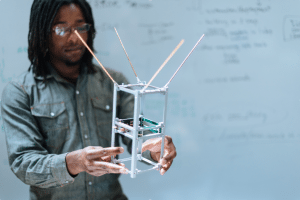Latest News
[Via Satellite 01-29-2015] Spire, formerly known as Nanosatisfi, unveiled plans to launch and operate a constellation of 20 commercial weather SmallSats by the end of 2015. The satellites have already been manifested on different launch vehicles around the world and will use a technique known as Radio-Occultation (RO) to provide precise and accurate meteorological measurements such as temperature, wind and moisture from space.
Spire’s satellites will use measurements from Global Navigation Satellite Systems (GNSS), pulling data from signals as they pass through the Earth’s atmosphere to provide a starting level of 10,000 soundings per day. Over the next two years, that number would grow to 100,000 daily soundings, providing a massive influx of commercially provided data.
“We are going to deliver something an order of magnitude more accurate, and 100 times more of it. And that is going to change dramatically our ability to forecast the weather as well as climate activity,” Peter Platzer, CEO of Spire told Via Satellite.
Spire has orbited four satellites to date, and has built on these spacecraft to reach the iteration that will launch this fall. Platzer said each satellite would weigh less than 10 kilograms and carry two primary sensors. Beyond GNSS-RO, the satellites will carry other sensors that would augment the value of the RO data being provided.
Spire raised $25 million in Series A funding during the summer of 2014, bringing its total amount to $29 million. The company already has customers in a variety of verticals, but Platzer said weather was planned to be a focus from the company’s inception.
“Everyone talks about the weather and doesn’t do anything about it,” he said. “That’s just unacceptable. That’s not how Silicon Valley approaches problems. We will do something about it — we will change it.”
With the U.S. National Oceanographic and Atmospheric Administration (NOAA) facing an impending weather data gap, an increasing amount of focus has been placed on leveraging commercial options as well. Last year NOAA issued a Request for Information (RFI) on RO that piqued interest from the commercial sector. Congress has also urged the agency to leverage private sector capabilities.
Platzer said the reasons satellites made sense as the best way to provide global weather data is the need to cover all of the world’s oceans. Spire emphasizes covering parts of the world that remain less studied due to inaccessibility.
Commercial weather by satellite is a burgeoning concept that a number of startups are pursuing, but Platzer is confident that, by launching this year, Spire will get a significant head start.
“The only one that actually has the money in the bank, launch slots booked and satellites developed is Spire,” he said. “I also think that in terms of rollout plan and actual ability, that Spire is probably a significant number of years ahead in actually being able to deliver something.”
Platzer added that he sees the market for such data as large, and that for other companies to bring similar services online would be beneficial for forecasting and modeling without creating an overabundance. Once Spire’s initial constellation is in place, the company plans to scale up with many more satellites. Platzer said this could be around 100 spacecraft, but that he is less concerned with the number. The goal for the constellation is to ultimately provide 100,000 profiles per day, covering the entire planet every five minutes. The spacecraft would deorbit every five to seven years, and through both software and hardware Spire would regularly improve the constellation.
“The software we’ll upgrade on an ongoing basis. It’s the ‘iPhoneization’ of space. We upload firmware into our radios and software onto our analytics platform on a daily basis already today to upgrade the capabilities of the hardware. Every six to 12 months we will replace a quarter or 50 percent of the constellation and upgrade the hardware. Number of satellites is not necessarily the right measure. Its more what capability do you have,” he said.
Get the latest Via Satellite news!
Subscribe Now